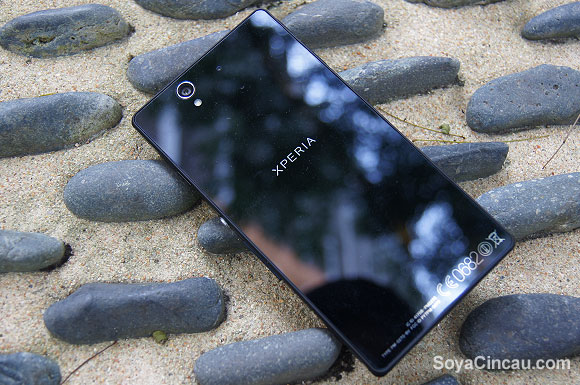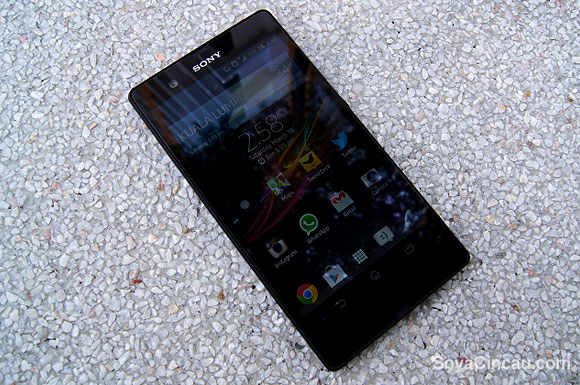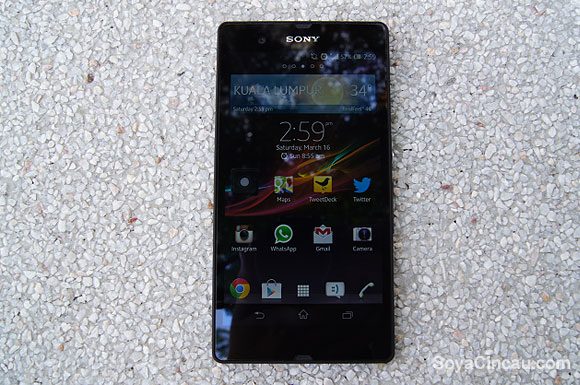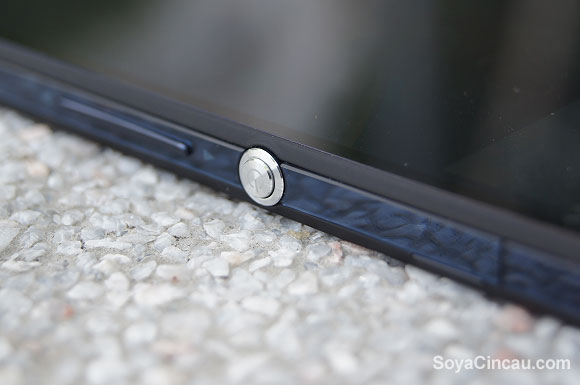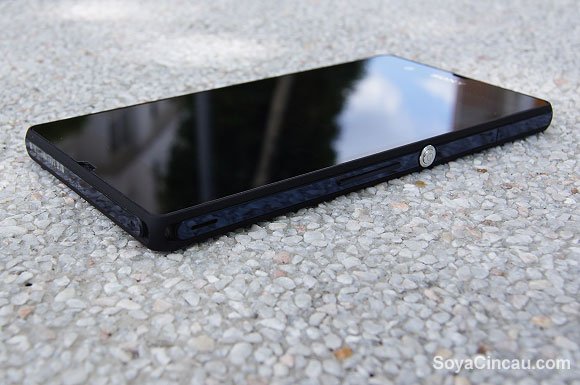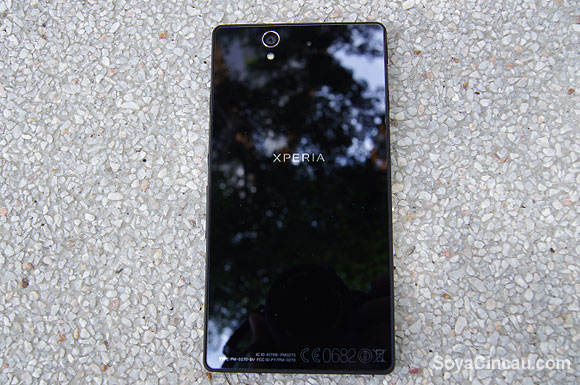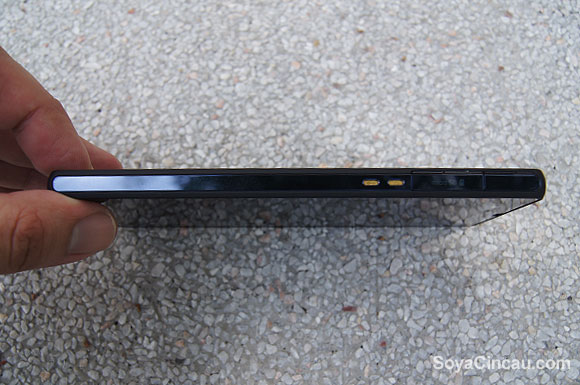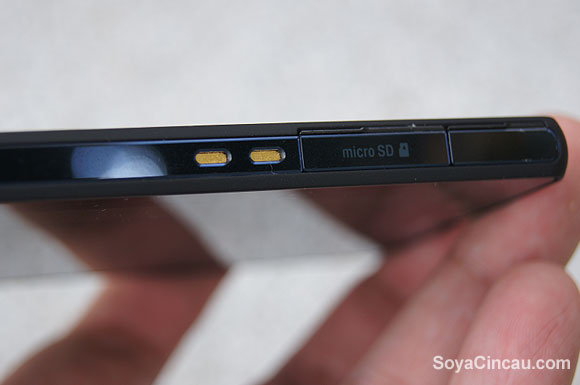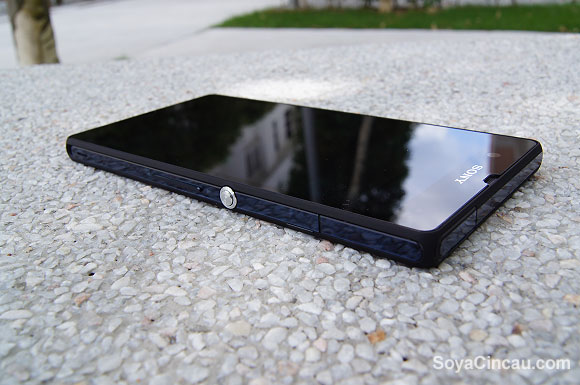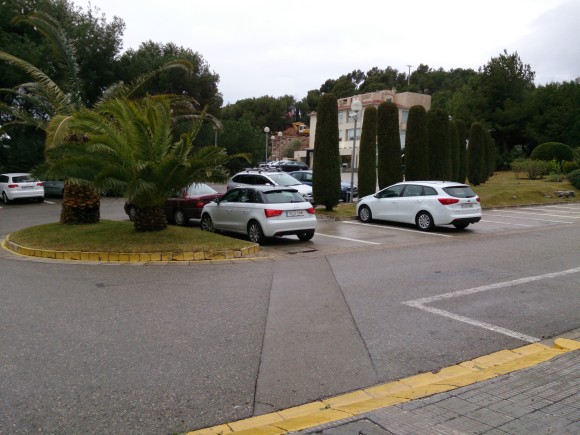For the second year in a row, Sony has been the first to release its flagship device in a brand new year. It was about a year ago when Sony had announced its Xperia S, which dropped its “Ericsson” name and featured its first ever dual-core smart phone device. It was a time where Sony Xperia is playing catch up with its rivals with a unique transparent belt design and a high density 720p display which remained unchallenged for a significant duration.
Fast forward into 2013, Sony has a greater challenge to face and expectations are much more demanding than before. Build quality becomes a growing concern as plastic are being scorned upon. In the last quarter of 2012, Sony is seen experimenting with more water resistance on higher end models which previously was limited with low spec hardware.
With just a limited combination of alphabets available for its Xperia line up, Sony had decided to jump to the very end – The Xperia Z, dubbed as the best of Sony in a smart phone. Read on for the full review.
Hardware

Being a flagship device for Sony, it has to be something memorable and iconic. The all new Sony Xperia Z comes with super slim form factor that’s wrapped with glass on both front and back. Even the sides are covered with reflective materials which gives an illusion that the entire build is made from a single block of glass. It is symmetrically designed with all sides being completely flat without any fancy curves and slopes.
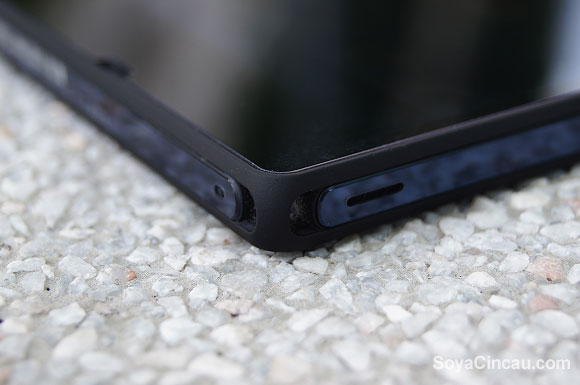
The side of the Xperia Z is wrapped with rubbery yet solid material which curves nicely on all 4 corners. In the hands, the Xperia Z looks and feels like a perfectly cut plexiglass that’s thinly wrapped with rubberised frames.
Just like how Sony had the transparent belt a unique feature, this year they have put more emphasis on the aluminium power button located at the right side which stands out prominently from the rest of the phone. At the front, it’s completely black with the earpiece and microphone grills being identical with tiny micro holes.
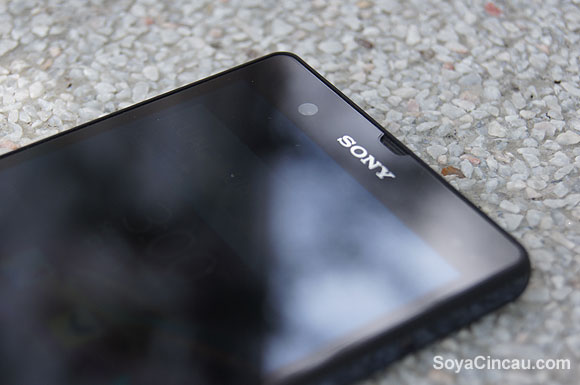
At the top lies a 2MP front facing camera and the notification light comes in a form of a discreet LED that’s hidden towards the right. The overall dimension feels rather compact thanks to its thinner bezel and the lack of capacitive buttons at the front.
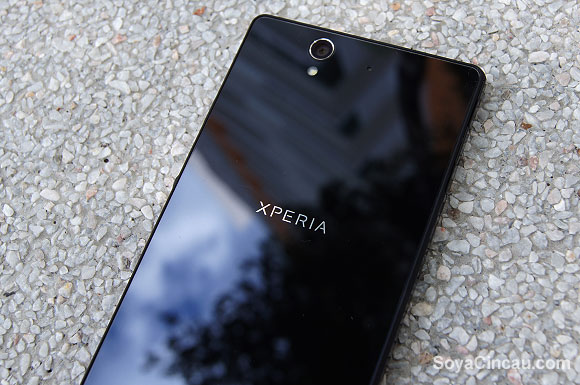
The similar design continues towards the back which is made entirely out of glass. The Xperia brand is prominently placed at the centre without any fancy logos to distract. Over at the top there’s a 13MP camera with assisted flash and a secondary microphone placed next to it for noise cancellation and video recording. On the right side, you’ll find the volume rocker placed below the power button as well as a tiny slit grill which houses the loud speaker. The only complaint with the speaker placement is that it tends to get covered by the palm when the device is held with the right hand.
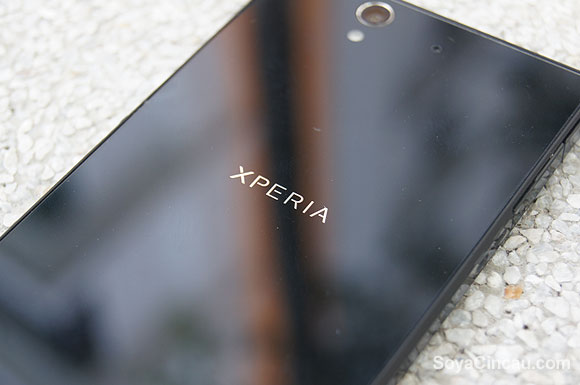
The front and rear glass panels toughen with tempered glass that’s protected with a layer of anti-shatter film which is actually more of a permanent screen protector. Despite its tough screen credentials, the Xperia Z isn’t really a phone that you can scratch your keys on it. The anti-shatter film is very prone to scratches and we have gotten some hairline scratches on both front and back which is rather noticeable.
The anti-shatter film also tends to add more friction when you swipe your finger across. Running a finger on the screen doesn’t feel as smooth as other devices such as the Galaxy S III or HTC Butterfly which tend to feel more Oleophobic. For those swiping to the edges a lot especially when switching tabs in Chrome, you’ll find the stiff flat edges on the Xperia Z is less comfortable than devices with curved glass edges.
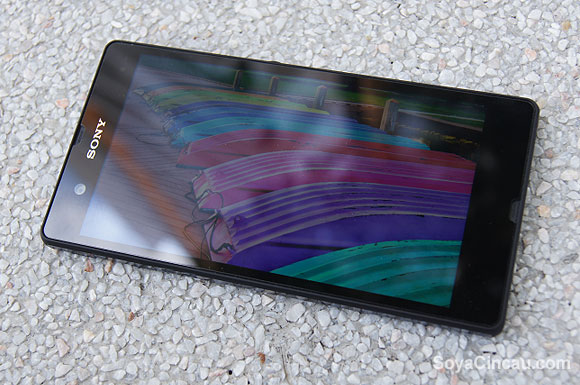
In terms of display, Sony is pushing this as an ultimate HD experience with a 5.0” display that gives 443 ppi (pixels per inch) at 1920×1080 pixels resolution. This is like fitting your Full HD TV into a pocketable device. The display is amazingly sharp with no noticeable individual pixels at sight. Colours tend out all right and with software enhanced colours if the Mobile Bravia engine is switched on.
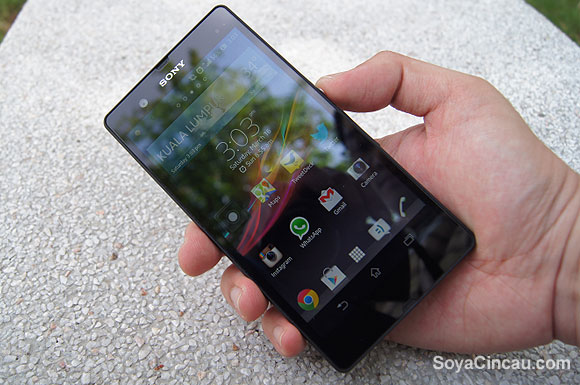
The display viewing angle could have been improved on the Xperia Z. When viewing web pages, the light coloured links starts to appear washed out when titled from the sides. This isn’t really a big problem since most of the time you would be viewing it straight as a personal device. With the HTC Butterfly with its 5” Full HD display placed side by side, the Xperia Z looks washed out as the Butterfly display appears to be superior with vibrant colours and wider viewing angles.
Going into its internals, the Xperia Z packs a quad-core Qualcomm S4 Pro processor that’s clocked at 1.5GHz, 2GB of RAM and 16GB of on-board storage. The Xperia Z is also Sony’s first foray into quad-core devices just like how it did with the Xperia S being the first dual-core device.
Connectivity
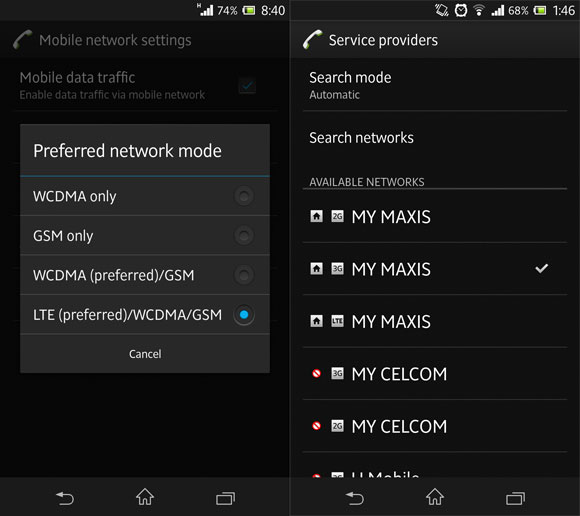
In terms of connectivity, it supports GSM HSPA+ as well as 4G LTE which supports our local Band 7 frequency of 2600MHz. At time of writing, our efforts to connect to a LTE connection seems to be futile With a Maxis SIM Card, we managed to scan for Maxis LTE base stations but we are unable to connect to any of them. We are advised at a Maxis centre that any mobile data plan are LTE capable provided you have the newer 3.5G supported SIM card and an LTE device. Despite being able to search for LTE stations, we are told that many of them are not ready yet. Looks like it will take some time for LTE coverage to be wide enough for any practical use.
NFC is also a standard on the Xperia Z which is located slightly above the Xperia logo at the back. One thing we noticed is the NFC contact point of the Xperia Z is rather small, making it harder to initiate a transfer. At MWC 2013, we struggled to beam over sample photos and videos from the Xperia Tablet Z as we have to precisely align both tablet and phone NFC sweet spots. This is probably the reason why some Xperia Z are seen with a small NFC sticker at the back for guidance.
Water & Dust Resistance
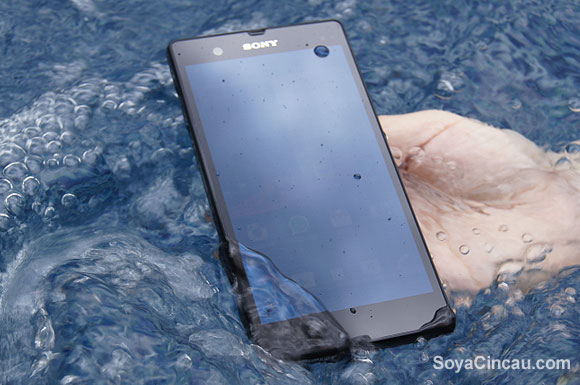
The Xperia Z also shines as a water and dust resistive device with IP55/57 rating. According to Sony, the Xperia Z is able to withstand being submerged under water up to 1 metre for 30 minutes. As shown before, the Xperia Z works great as an underwater camera and it manages to pick up audio pretty well. We had a lot of fun doing this and certainly open up more creative possibilities when it comes to shooting photos and videos.
The display however reacts very differently when it make contact with water. With droplets or streams of water, the screen registers random touches all over which makes it barely usable. When the Xperia Z is fully submerged, the entire screen locks up completely. In order to shoot photos or videos, you would either need to start recording or set the timer on before going under. Once the device is out of the water, the tiny loud speaker grill tends to accumulate water droplets which muffle the overall speaker loudness. You’ll need to wait for it to dry out before it can play audio normally again.
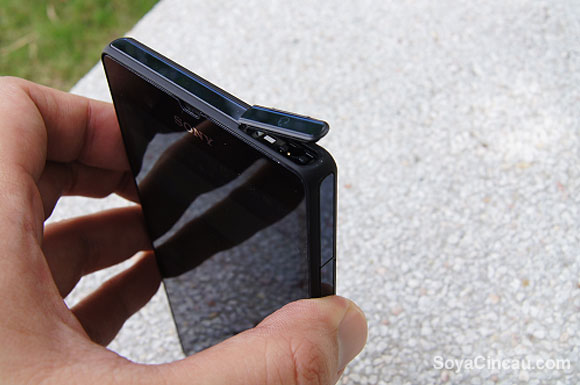
Being a water resistant device, the Xperia Z comes with flaps galore. It comes with individual flaps with rubber linings for the headphone jack, microSD slot, micro USB slot and micro SIM tray. The flap cover plastics look quite tough but we are not sure how long will it stand with frequent usage especially for the micro USB charging port. If charging is a hassle, the Xperia Z comes with 2 golden contact points on the left side for in-dock charging.
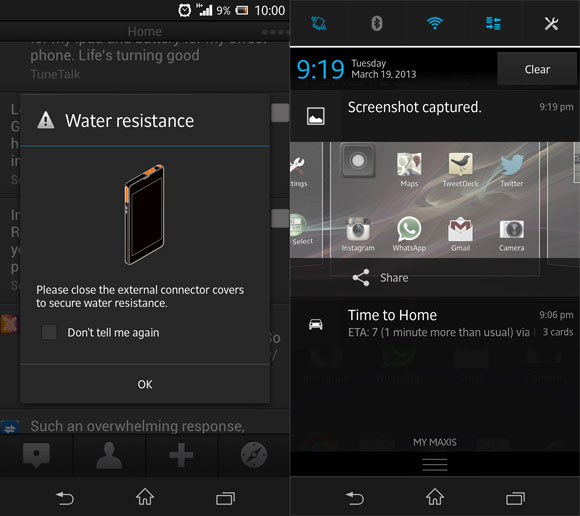
All flap covers must be completed sealed before getting wet. To detect possible damage caused by improper closure of flaps, there are moist indicators in all ports which changes colour if it gets wet. After disconnecting the charging cable, the Xperia Z also prompts a warning to ensure all covers are closed properly. If you haven’t seen it yet, check out our swimming with the Xperia Z video below:
User Interface
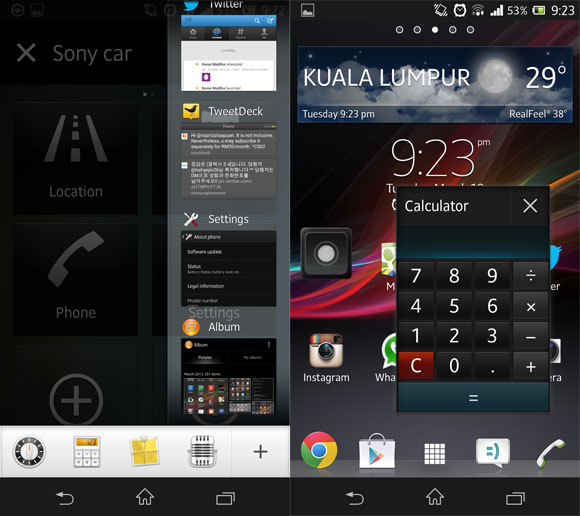
The Xperia Z runs on the recent Android 4.1.2 Jelly Bean which comes with Sony’s very own Cosmic Flow skin. The unlock screen comes with a blind effect that interacts when you unlock by swiping vertically. Hitting the recent app/task switcher button, the Xperia Z gives access to mini-apps which are basically floating apps such as Calculator, Timer and Notes which runs on top of your active application. However you only can run one mini-app at one time.
Since there’s no physical front buttons, the Xperia Z uses on screen buttons take takes a portion of the screen. The overall interface along with its built in applications are rather polished. Dragging down the notifications bar also gives you direct toggle access to sound profile, Bluetooth, wifi, mobile data and settings which is a nice touch. Another thing we noticed is that Sony has ditched the typical native web browser app and has gone with Chrome as the default browser.
Camera
Since the Xperia Z lacks a dedicated camera button, the only quick access to camera is from the home screen. Despite its quad-core processor, launching the camera tends to be rather sluggish. Sometimes even from the home screen, there’s a noticeable 1-2 second delay before the camera is ready to shoot. It is worth pointing out that starting the camera from the home screen by default goes into Superior Auto mode which shoots at maximum of 12MP instead of 13MP. If you can’t decide how to record the moment, the Xperia Z lets you shoot pictures while recording a video. However your photos are saved with a maximum resolution of 1MP.
With burst mode being a rage lately, the Xperia Z is capable of shooting up to 10fps with almost infinite number of shots. To shoot in burst mode, you’ll need to manually change the mode to burst and you have a choice of 3 speed settings – Low (2MP), Medium (9MP) and High (1MP). Earlier we managed to shoot beyond the 1,000 shots and the counter just stops tracking as it continued shooting. While shooting in burst mode, the Xperia Z tends to heat up very quickly and the camera was automatically disabled after shooting due to high temperature.
In terms of quality, the Xperia Z despite its 13MP sensor appears to be rather noisy for our liking. At normal view, it looks rather decent with visible photos in low light conditions but 100% crop shows a rather smudgy output. Among a few niggles we have on the camera is the rather sluggish on-screen shutter button. Right after taking a picture, it takes quite a while before it is ready to take the next shot. Hopefully there’s a firmware update to improve the photo quality and camera load times.
Sample Videos
You can check out our camera shootout of the Xperia Z vs Butterfly over here.
Performance
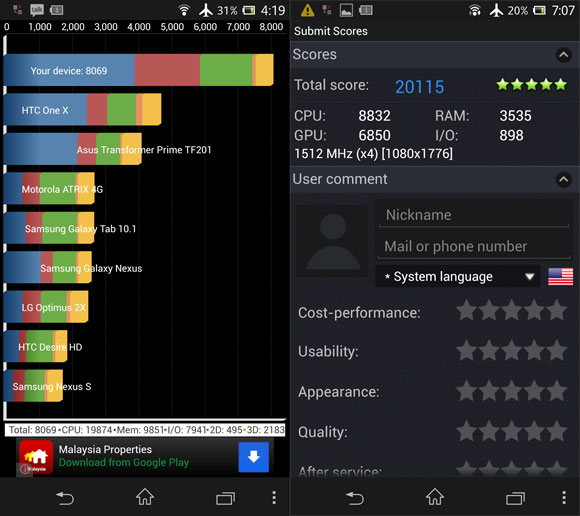
With a quad-core processor, the Sony Xperia Z is a rather snappy device. It manages to score 8069 points in Quadrant and 20115 points in AnTutu. For comparison, the HTC Butterfly with similar Quad-Core 1.5GHz processor and 2GB of memory scored slightly higher on Quadrant at 8,170 points and a lower 18,910 points on AnTuTu.
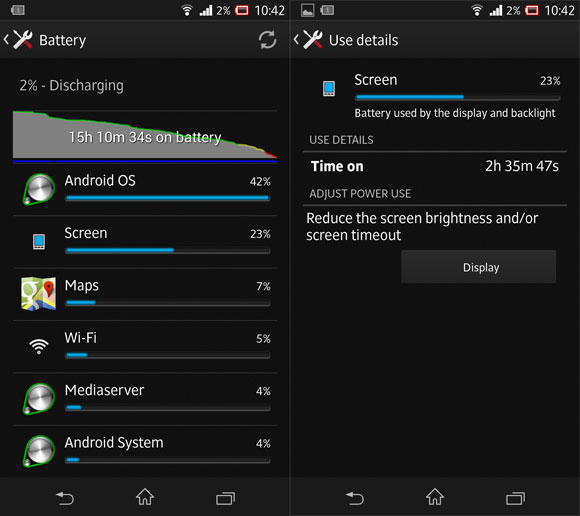
The Xperia Z comes with a non-removable 2330mAh battery which lasted pretty long with 13-15 hours of average use with syncing and notifications enabled. If you need to squeeze more juice, there are more power management features such as stamina mode that cuts down power usage by disabling data and non vital features when the screen is off.
Conclusion
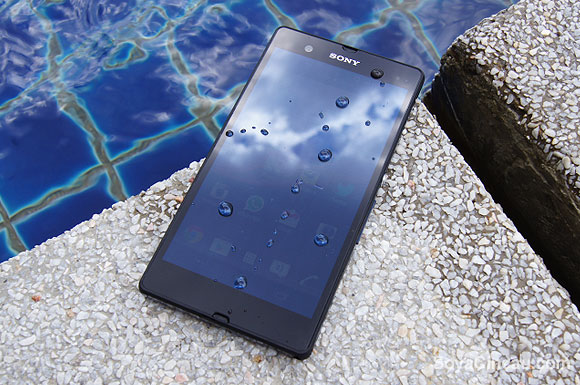
The Xperia Z started 2013 with a bang but it now faces serious contenders like the aluminum clad HTC One and the “smart feature” packed Samsung Galaxy S4. In terms of internal hardware, the Xperia Z starts to lag behind its new rivals however it still stands out in terms of design. Having a unique design is one of Sony’s key strengths and it is commended that they dare to come out with fresh approach for this year’s flagship. The usage of glass for both sides isn’t entirely new but they have adapted it nicely with super slim 7.9mm dimensions which looked rather sexy. It is just a pity that its uprated 13MP shooter is lacking a dedicated camera button which could make photo shooting more instant.
The water resistance feature is definitely a big plus for the Xperia Z, an area which not many device manufacturers have ventured into. While using your phone in water may not be a daily affair, it does give that sense of security for those unexpected moments like a surprise throw into the pool or simply being soaked in heavy rain. Currently the Xperia Z is among the best looking and performing Android that’s available on sale right now with the price tag of RM2,199. For those that prefer something smaller, there’s the Xperia ZL that retails at RM1,899 which comes with similar hardware minus the water/dust resistant feature.
Xperia Z Hands-On Video
Photo Gallery

